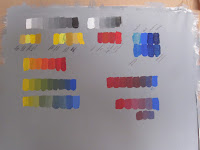For my first study I prepared a collage with mono-chrome pen and ink background. In the image I tilted the board creating a false perspective and used magazine text to add tone to the board. I was pleased with the contrast between the coloured foreground and predominantly black and white background.
Using a pencil study in my A6 sketchbook, I worked out tonal qualities of the still life and the impact on its composition. I prepared the sketch from memory whilst travelling on a train into London.
I continued with a colour study in my approx A4 sketchbook returning to the blue and orange contrast combination I like. I used this study to experiment with applying acrylic paint to with a palette knife to add texture to the tall vase. I also experimented with acrylic gloss medium adding this to the "Mother Hen" and jug. By only using the gloss medium on two objects in the still life I discovered that the effect was to confuse the painted highlights from the reflections off the gloss medium.
I felt the view adopted so far was too similar to that used for earlier exercises so I changed my view point and working in my sketchbook produced a new line sketch to which I tried out colours.
Having decided on a the view point for my composition I proceeded to block out areas on my prepared support with acrylic washes.
I gradually build up the tones and hue mixes on the foreground objects. I wanted to maintain a warmth and true to scale proportions to the perspective overall. I also wanted to create a feel of interest beyond the view painted - what was behind the doors? what was Mother Hen looking at?
I, therefore, adjusted the doors so that the left hand door appear to be partially open and increased to brilliance of the table's orange finish. On reflection I realised the table's hue was drawing the viewers eye away from the main subjects. Also the tall vase appeared lost against the background.
I toned down the table to a more realistic colour and added warmth to the vase to help it stand out. I adjusted the hue of the vase further to increase the contrast between it and the jug by lightening the vase. Finally I modified highlights to the objects and added reflection to the picture in the background. I am particularly pleased with the quality of light that I have created within the picture.
By showing more of the room in which the still life was set up the composition has become busier and has created a storey beyond the man-made objects. As an illustration that effect may be useful. However as an image in its own right, I prefer the focus more on the sill life subjects as created in an earlier exerice. Framing the work helps to improve the focus too.
Compared to my work for Assignment 1, I believe I have improved the composition and my use of colour. I have stretched myself further too in exploring how to paint interior perspectives.














































